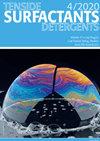在热致伸缩性表面活性剂为基础的向列液晶中配制添加剂
IF 1.2
4区 工程技术
Q4 CHEMISTRY, APPLIED
引用次数: 0
摘要
将两种 HLB 非常不同的乙氧基化烷基醚羧酸表面活性剂以一定的摩尔分数混合在水中,可以形成双胞。我们确定了在保健和家庭护理配方中添加丙二醇、甘油和乙醇这三种最常用添加剂的效果。我们确定了添加剂的效果,并在 LCST 以上的浓缩各向同性相、假胶束相和盘状向列相中进行了比较。后两者具有双折射性,而向列相具有粘弹性。丙二醇可作为助溶剂,提高向列相的温度稳定性,最高可达 20 wt%。丙二醇的进一步添加会降低相变温度,并由于头基团脱水和亲水性短链表面活性剂的优先溶解而引起微观结构的变化。甘油是一种反溶剂,通过头基脱水逐渐降低相变温度。乙醇是表面活性剂混合物的良好助溶剂。添加多达 5 wt% 的乙醇可提高向列相的温度稳定性。乙醇浓度越高,形成的各向同性相越单一,表面活性剂的分子溶解度越高。高分辨率 X 射线散射跟踪了所考虑的添加剂对分子堆积的影响。本文章由计算机程序翻译,如有差异,请以英文原文为准。
Formulating additives in thermoresponsive surfactant-based nematic liquid crystals
Bicelles can be formed by mixing in given mole fractions two ethoxylated alkyl ether carboxylic acid surfactants of very different HLB in water. We determine the effect of adding three of the most used additives in formulation in health- and home care: propylene glycol, glycerol, and ethanol. The effects of additives are determined and compared in a concentrated isotropic phase above the LCST, a pseudo-lamellar phase, and a discotic nematic phase. The two latter are birefringent, and the nematic phase is viscoelastic. Propylene glycol acts as a co-solvent, improving the temperature stability of the nematic phase up to 20 wt% propylene glycol. Further addition of propylene glycol reduces the phase transition temperatures, inducing microstructural changes due to headgroup dehydration and preferential solubilization of the hydrophilic short chain surfactant. Glycerol acts as an anti-solvent, progressively decreasing phase transition temperatures by dehydration of headgroups. Ethanol is a good co-solvent for the surfactant-mixture. Adding up to 5 wt% ethanol increases the temperature stability of the nematic phase. Higher concentrations of ethanol lead to a single isotropic phase with increasingly molecular dissolution of the surfactants. The effect of the considered additives on molecular packing is followed by high resolution X-ray scattering.
求助全文
通过发布文献求助,成功后即可免费获取论文全文。
去求助
来源期刊

Tenside Surfactants Detergents
工程技术-工程:化工
CiteScore
1.90
自引率
10.00%
发文量
57
审稿时长
3.8 months
期刊介绍:
Tenside Surfactants Detergents offers the most recent results of research and development in all fields of surfactant chemistry, such as: synthesis, analysis, physicochemical properties, new types of surfactants, progress in production processes, application-related problems and environmental behavior. Since 1964 Tenside Surfactants Detergents offers strictly peer-reviewed, high-quality articles by renowned specialists around the world.
 求助内容:
求助内容: 应助结果提醒方式:
应助结果提醒方式:


